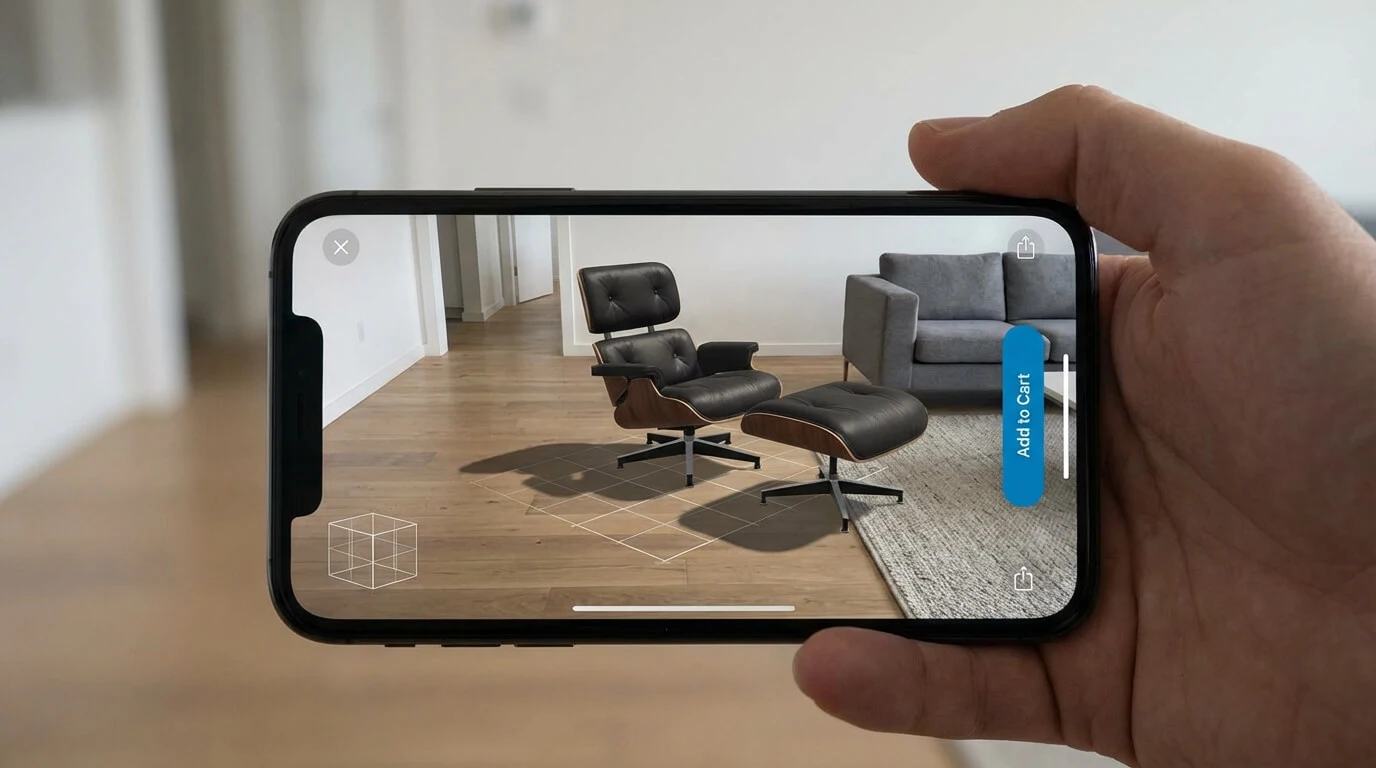What is augmented reality?

CGI for strong brand presences
From hero renders to campaign assets: Our 3D studio delivers high-quality 3D images and animations that sell – and seamlessly integrate into your CI. Get a non-binding assessment.
What is augmented reality?
What is augmented reality (AR)?
Augmented reality - AR for short - superimposes virtual 3D elements into the real environment so that both levels react to each other live. Unlike virtual reality, the user remains in their physical world, but receives context-related, interactive additional information.

How it works - step by step
Step 1: Sensors & tracking
Camera, LiDAR or ToF sensors detect depth, position and movement.
Step 2: Spatial mapping
The sensor data is used to create a low-poly mesh of the room for collision detection.
Step 3: Rendering
A render engine adapts the light and shadow of the 3D objects to the real scene.
Step 4: Interaction
Touch, gesture or voice input changes the position, color or variants of the objects in real time.
AR viewer in action: a photorealistic 3D chair is placed to scale in the living room - allowing customers to experience furniture before they buy.

Want to know how we can visually boost your brand with CGI?
We'll explain the process, effort, and output of CGI product images for your brand communication for your furniture, home & living brand – transparently and without obligation.
Learn more nowAR vs. VR vs. MR vs. XR - Overview
Symbol legend
✔= applicable / available
✖= not available
= partial / in simple form
- not applicable (because the real world is hidden)
In a nutshell:
AR places a 3D object over your camera image.
MR goes further: The 3D object really interacts with your physical environment -> Mixed Reality.
VR completely replaces the environment.
XR is just the generic term for all three.
Market potential 2025
Global AR sales ≈ USD 120 billion (2025 forecast) - Grand View Research article
Apple launches Vision Pro, the first widely marketed "spatial computer headset"(release February 2025)
Enterprise solutions dominate, but consumer AR wins with VisionOS apps and Android smart glass form factors - 2025 Augmented Reality (AR) Trends
Benefits for Home & Living brands
Real-life preview: Customers place a sofa, carpet or lamp in their own room.
Variant configurator: fabric and color change in seconds, ideal for e-commerce.
Exhibition stand2.0: fewer physical prototypes, but interactive AR models on the tablet.
Content recycling: The same 3D asset is used for the AR app, online configurator and print render.
Typical workflows
Backstage at Danthree Studio: Our team optimizes CAD data, material samples and PBR maps so that products later appear seamlessly in augmented reality.
FAQs - Augmented Reality
Which devices support AR 2025?
- Apple Vision Pro
- iPhone 14 Pro + (WebAR via Safari & USDZ)
- Android devices with ARCore/Scene Viewer
- Meta Quest 3 (Passthrough-AR)
Do I really need a headset?
No. Basic AR already works in the smartphone browser - see Apple's overview "Augmented Reality on iPhone & iPad".
How do I scale high-poly models?
Microsoft's Azure Remote Rendering streams CAD data as ray tracing frames to mobile hardware.
Which authoring tool for materials?
Adobe Substance 3D - Mixed Reality Guide exports optimized PBR shaders directly as glTF/USDZ.
Which engine is state of the art?
Unreal Engine XR offers Lumen GI & Path Tracer (5.4) for AR projects. → Unreal XR
What does XR mean?
XR = Extended Reality - collective term for AR, MR and VR.
Which file formats work most reliably in the browser today?
USDZ is the native container format for iOS devices - Apple explains in its developer documentation on the AR Quick Look - USDZ Overviewhow it handles PBR materials, animations and compression. On Android and desktop, glTF/GLB has established itself as the standard because it is lightweight and open source.
Does AR demonstrably generate more sales?
According to the Shopify analysis "The Thrilling Evolution: 3D Ecommerce and a New Era of Retail", stores that use 3D/AR viewers achieve 94% higher conversion rates on average. In addition, the Gunner Kennels case study in the article "AR Shopping: Future Trends & Apps" shows a 40% increase in conversion and 5% fewer returns because customers can check the size and fit realistically in advance.
